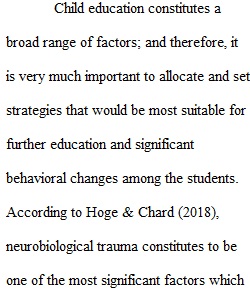


Q EDEC 447: Emotional Development and Mental Health Issues: Trauma Tool Kit How can you prevent trauma in the population you are serving or hope to work with? How can you support and intervene effectively with those affected by trauma? Trauma may be circumstances like child abuse and neglect, medical crises, war, community violence, natural disaster, death in the family, separation of families, pandemics, etc. Research: The research for this project is the reading from Trauma-Informed Practices For Early Childhood Educators and at least 2 additional resources from the materials on Canvas. Here are 2 additional sites that may help with specific age groups or interventions. 1. Online training module on Trauma from the Georgetown Center for Early Childhood Mental Health Consultation. Link: https://www.ecmhc.org/tutorials/trauma/index.html (Links to an external site.) 2. National Child Traumatic Stress Center information on preschool and elementary aged children. Link: https://www.nctsn.org/resources/child-trauma-toolkit-educators (Links to an external site.) (Links to an external site.)Choose one age group/ population: Infants (birth – 12 months), toddlers (12-36 mos.), preschool (36-60 mos.), primary grade (ages 5-8), adults (parents, caregivers, professionals - If the adult caregivers are not getting the support they need it is challenging to adequately support the children. Trauma Tool Kit Sections Section One: The Neurobiology of Trauma. Review Trauma-Informed Practices For Early Childhood Educators, Chapter 1: Understanding The Neurobiology of Trauma. The Key Topics Covered: • Brainstem, limbic brain, neo-cortex • Arousal states • The impact of stress on the developing brain • Defining trauma and types of trauma • The impact of trauma on young children’s development and capacity to learn • Attunement, co-regulation, and mirror neurons Having a solid foundation in the neurobiology of trauma will make you a stronger professional. You will summarize key points from this chapter. All the topics are important and interrelated. Choose 4 of the key topics to summarize. Include how this information may relate to how you work with children. Example: you plan to be a speech therapist, one possible impact of trauma is delayed language development. Example: You plan to be a teacher (or any professional), understanding attunement, co-regulation and mirror neurons will help you interact effectively with your students or clients. (2-3 pages) Section two: What are potential sources and signs of trauma for the age group you chose? You are not qualified to diagnose anyone with trauma, but you will begin to recognize events and circumstances that may lead to trauma. Trauma will look different in different children depending on their temperament, family situation, age, etc. Some children may act out others may withdraw. What might you observe in the age group you chose? (1-2 pages) Section three: Put on your professional hat - speech therapist, child life specialist, parent educator, teacher, etc. What are classroom, family, or professional strategies you can include to be a trauma-informed professional? I want this to be useful to you. Look for resources you could use immediately if you are teaching/ working with children or you could use in the future in your scope of work. Think about the strategies in building attuned relationships, setting up healing environments and direct teaching of social-emotional skills. If you are focusing on the adult caregivers, teachers, etc, think about self-care and reflection. Think about prevention and intervention strategies. For the setting you are working in: Choose 5 strategies you will use in your setting. Explain why you chose them, what is the purpose and how you will implement these strategies in the population you chose. Be detailed. You can use strategies from Chapter 3, Trauma-Sensitive Early Childhood Programs or other sources. (2-3 pages) Bring one of your strategies to class to share with a small group – You can bring a written explanation, curriculum material, a book, etc. Ex. A mindfulness activity, stress reduction, emotional regulation, emotional literacy, etc. Be prepared to share it/ teach it with a small group. Section four: Community resources: Identify a community resource here or in your home community you could use as a referral for a family or professional. Why did you choose the resource? Is it accessible (cost, eligibility, location, etc)? How would you introduce it to the family or professional? (1 page) Section five: Reflection What do you know about trauma informed practice that you didn’t before? How might this change your professional practice or interactions with others? What are steps you can take in your professional practice around reflection and self-care? (1 - 2 pages) Total Pages: 8-11 pages – 8 pages means you are a very strong and efficient writer. Most students need 9-11 pages to adequately cover the assignment. You will turn this in on Canvas. Grade Sheet: Section One: The Neurobiology of Trauma: 15 points Section Two: Identification (sources and signs of trauma): 10 pts Section three: Strategies: 20 pts. Section four: Community Resource: 5 pts. Section five: Reflection: 5 pts. Writing/ Critical Thinking: 5 Total: 60 Additional Resources for focusing on parents/ guardians and teachers/ caregivers: • http://www.ecmhc.org/relaxation.html (Links to an external site.): Resources from the Georgetown Center for Early Childhood Mental Health on stress management for teachers and parents. • http://www.proqol.org/ProQol_Test.html (Links to an external site.): Professional Quality of Life Scale (ProQOL) Compassion Satisfaction and Compassion Fatigue (ProQOL) Version 5 (2009) When you [help] people you have direct contact with their lives. As you may have found, your compassion for those you [help] can affect you in positive and negative ways. • http://www.nctsn.org/resources/topics/secondary-traumatic-stress (Links to an external site.) Resources from the National Child Traumatic Stress Network PreviousNext
View Related Questions